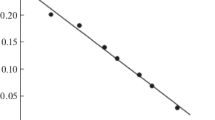Abstract
Fluorescein isothiocyanate was used as a label to detect delta-endotoxin ofBacillus thuringiensis subsp.thuringiensis andisraelensis in binding studies with different in vitro cell systems. Protoxin of the subspeciesthuringiensis could be labelled directly whereas the activated toxin had to be traced indirectly with labelled antibodies. Both protoxin and activated toxin bound to primary midgut cell cultures ofPieris brassicae larvae as well as to cells of an established culture ofDrosophila melanogaster. No binding with either toxin form could be observed with hemocytes ofP. brassicae. Biological activity as shown by the trypan blue viability assay was obtained only with the activated toxin against the midgut cells. Toxin of the subspeciesisraelensis reacted very unspecifically. Binding followed by rapid destruction was obtained with all the tested cultures.
Similar content being viewed by others
Abbreviations
- FITC:
-
fluorescein isothiocyanate
References
Arbuthnott JP (1978) Role of exotoxins in bacterial pathogenicity. J Appl Bacteriol 44:329–345
Armstrong JL, Rohrmann GF, Beaudreaus GS (1985) Delta-endotoxin ofBacillus thuringiensis subsp.israelensis. J Bacteriol 161:39–46
Delafield FP, Somerville HJ, Rittenberg SC (1968) Immunological homology between crystal and spore protein ofBacillus thuringiensis. J Bacteriol 96:713–720
Grace TDC (1962) Establishment of four strains of cells from insect tissue grown in vitro. Nature 195:788–789
Huber HE, Lüthy P, Ebersold H-R, Cordier J-L (1981) The subunits of the parasporal crystal ofBacillus thuringiensis: Size, linkage and toxicity. Arch Microbiol 129:14–18
Huber-Lukač M, Lüthy P, Braun DG (1983) Specificities of monoclonal antibodies against the activated delta-endotoxin ofBacillus thuringiensis var.thuringiensis. Infect Immun 40:608–612
Hurley JM, Lee SG, Andrews RE, Klowden MJ Jr., Bulla LA (1985) Separation of the cytolytic and mosquitocidal protein ofBacillus thuringiensis subsp.israelensis. Biochem Biophys Res Commun 126:961–965
Ibarra JE, Federici BA (1986) Isolation of a relatively nontoxic 65-kilodalton protein inclusion from the parasporal body ofBacillus thuringiensis subsp.israelensis. J Bacteriol 165:527–533
Insell JP, Fitz-James PC (1985) Composition and toxicity of the inclusion ofBacillus thuringiensis subsp.israelensis. Appl Environ Microbiol 50:56–62
Johnson DE, Davidson LI (1984) Specificities of cultured insect tissue cells for bioassay of entomocidal protein fromBacillus thuringiensis. In Vitro 20:66–70
Lüthy P (1975) Zur bakteriologischen Schädlingsbekämpfung: Die entomopathogenenBacillus-Arten,Bacillus thuringiensis undBacillus popilliae. Vjsch Naturf. Ges. Zürich 120:81–163
Lüthy P, Ebersold HR (1981)Bacillus thuringiensis delta-endotoxin: Histopathology and molecular mode of action. In: Davidson EW (ed) Pathogenesis of invertebrate microbial diseases. Allanheld, Osmun & Co Publishers, Totowa NJ USA, pp 235–267
Lowry DH, Rosebrough NJ, Farr AL, Randall RJ (1951) Protein measurement with the Folin-phenol-reagent. J Biol Chem 193:265–275
Ouchterlony O (1968) Handbook of immunodiffusion and immunoelectrophoresis. Ann Arbor Science Publishers, Ann Arbor Michigan USA
Rinaldini LM (1959) An improved method for the isolation and quantitative cultivation of embryonic cells. Exp Cell Res 16:477–505
Shields G, Sang JH (1977) Improved medium for culture of Drosophila embryonic cells. Drosophila Information Service 52:161
Thomas WE, Ellar DJ (1983)Bacillus thuringiensis var.israelensis crystal delta-endotoxin: Effect on insect and mammalian cells in vitro and in vivo. J Cell Sci 60:181–197
Wells AF, Miller CE, Nadel MK (1966) Rapid fluorescein and protein assay method for fluorescens-antibody conjugates. Appl Microbiol 14:271–275
Yousten AA, Rogoff MH (1969) Metabolism ofBacillus thuringiensis in relation to spore and crystal formation. J Bacteriol 100:1229–1236
Author information
Authors and Affiliations
Rights and permissions
About this article
Cite this article
Hofmann, C., Lüthy, P. Binding and activity ofBacillus thuringiensis delta-endotoxin to invertebrate cells. Arch. Microbiol. 146, 7–11 (1986). https://doi.org/10.1007/BF00690150
Received:
Accepted:
Issue Date:
DOI: https://doi.org/10.1007/BF00690150




